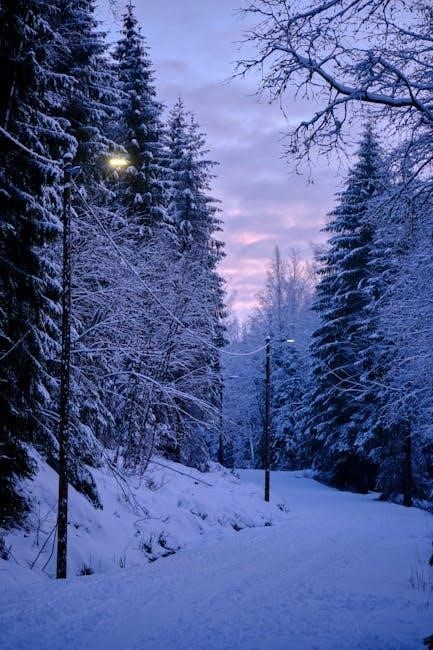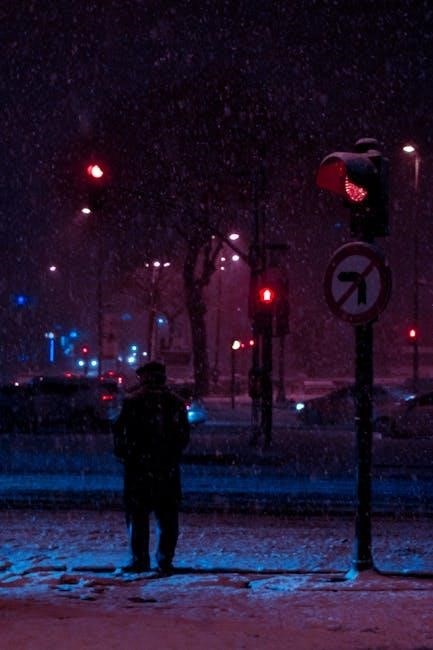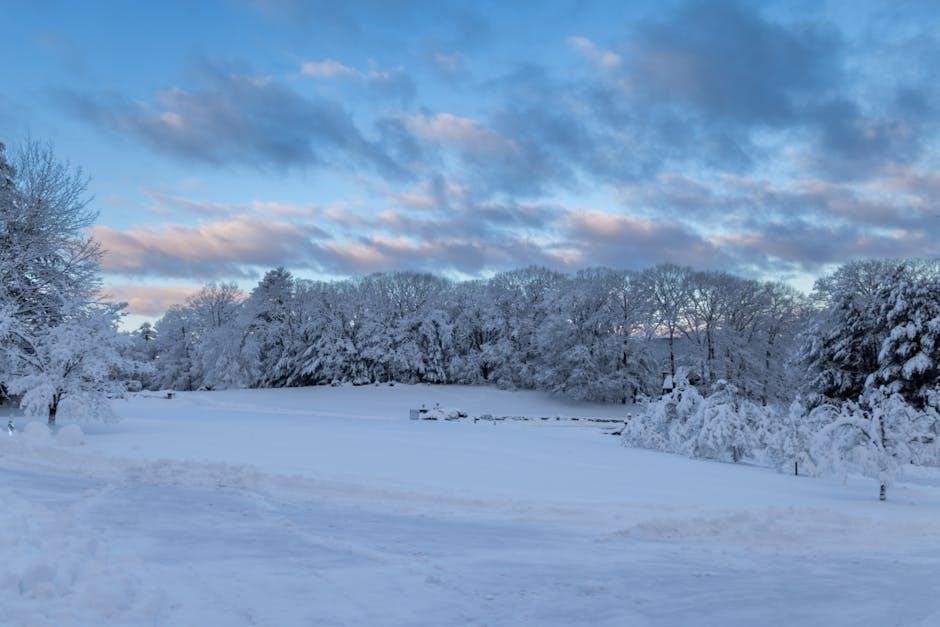Overview of “Stopping by Woods on a Snowy Evening”
Robert Frost’s “Stopping by Woods on a Snowy Evening‚” published in 1923‚ presents a traveler captivated by a snowy scene. The poem explores themes of nature‚ duty‚ and the allure of respite. Its accessibility contributes to its enduring popularity.
Robert Frost and His Work
Robert Frost (1874-1963) stands as a cornerstone of American poetry‚ celebrated for his evocative depictions of rural life and profound exploration of human experience. Frost’s poetry often delves into the complexities of nature‚ using it as a backdrop to examine themes of isolation‚ duty‚ and the search for meaning. He possessed an uncanny ability to depict the beauty of nature.
Frost’s style is characterized by its accessible language and traditional forms‚ making his work both widely appreciated and deeply resonant. “Stopping by Woods on a Snowy Evening” exemplifies Frost’s signature style‚ blending simple imagery with deeper philosophical undertones. His poems showcase the conflict between man and nature. Frost’s legacy rests on his ability to capture universal truths within the specific details of New England landscapes.
The themes highlight the difference between wishes and obligations we face in our lives.
Publication and Popularity of the Poem
“Stopping by Woods on a Snowy Evening” first appeared in Robert Frost’s 1923 collection‚ “New Hampshire‚” a volume that solidified his reputation as a major American poet. Soon after its publication‚ the poem quickly gained popularity‚ becoming one of Frost’s most beloved and widely anthologized works. Its accessible language‚ vivid imagery‚ and contemplative themes resonated with a broad audience.
The poem’s enduring appeal lies in its ability to evoke a sense of tranquility and introspection‚ while simultaneously hinting at deeper existential questions. Readers are drawn to the speaker’s momentary pause in the snowy woods‚ a scene that invites reflection on the balance between personal desires and societal obligations. “Stopping by Woods” has secured its place as a staple of English literature.
The poem’s popularity also stems from its seeming simplicity‚ which belies its rich layers of interpretation. This combination of accessibility and depth contributes to its continued relevance and appeal across generations.
The poem depicts a traveler pausing in snowy woods‚ contemplating nature’s beauty. Torn between the allure of rest and the call of duty‚ the speaker ultimately chooses responsibility‚ a central theme.
The Narrator’s Dilemma
The heart of “Stopping by Woods on a Snowy Evening” lies in the narrator’s internal conflict. He is drawn to the serene‚ snow-filled woods‚ a scene that captivates him on the “darkest evening of the year.” This attraction represents a desire for peace and escape from the demands of life; He finds himself at a crossroads‚ tempted to linger and immerse himself in the beauty before him.
However‚ this temptation clashes with a sense of obligation. The narrator acknowledges he has “promises to keep‚ and miles to go before I sleep.” These lines underscore his responsibilities and commitments that pull him back to the world of action. The dilemma is not merely a choice between rest and work; it symbolizes a deeper struggle between personal desires and social duties.
The pull of the woods is strong‚ offering a tempting escape from the burdens of everyday life. Yet‚ the narrator ultimately chooses to move forward‚ acknowledging the responsibilities that define his path.
Themes of Nature‚ Duty‚ and Death
“Stopping by Woods on a Snowy Evening” intricately weaves together themes of nature‚ duty‚ and death. Nature is presented as a captivating force‚ drawing the narrator into its serene beauty‚ symbolized by the “woods filling up with snow.” This allure of nature serves as a counterpoint to the responsibilities of human life.
Duty is emphasized through the narrator’s repeated acknowledgement of “promises to keep‚ and miles to go before I sleep.” These lines highlight the obligations that bind him to the world of action and responsibility‚ pulling him away from the tranquil escape offered by nature. He acknowledges the need to continue his journey‚ despite the temptation to linger.
The poem also subtly hints at the theme of death. The “darkest evening of the year” and the quiet‚ enveloping snow can be interpreted as symbols of mortality. The woods‚ in this context‚ represent a peaceful but final surrender;

Poetic Devices and Structure
Frost employs a consistent rhyme scheme and iambic tetrameter‚ creating a musical and memorable rhythm. Imagery and symbolism‚ particularly the woods and snow‚ evoke deeper meanings related to nature and inner conflict.
Rhyme Scheme and Meter
The poem “Stopping by Woods on a Snowy Evening” showcases a distinctive rhyme scheme that contributes significantly to its musicality and memorability; Frost employs an AABA‚ BBCB‚ CCDC‚ DDDD pattern across its four stanzas. This interwoven rhyme scheme creates a sense of continuity and forward momentum‚ drawing the reader deeper into the poem’s narrative and thematic exploration.
The consistent rhyme connects the stanzas‚ only broken in the final stanza‚ adding emphasis. Furthermore‚ the poem is written in iambic tetrameter‚ meaning each line consists of four metrical feet‚ with each foot containing an unstressed syllable followed by a stressed syllable. This regular meter contributes to the poem’s calming and hypnotic effect‚ mirroring the serene and contemplative mood of the speaker. The steady rhythm reinforces the feeling of a measured and deliberate pause in the snowy woods‚ highlighting the tension between the speaker’s desire for rest and the obligations that compel him to continue his journey.
Imagery and Symbolism in the Poem
“Stopping by Woods on a Snowy Evening” is rich in vivid imagery and potent symbolism‚ contributing to its profound and enduring appeal. The “woods” themselves represent more than just a physical location; they symbolize the allure of nature‚ the escape from responsibility‚ and perhaps even the temptation of death or oblivion. The “snowy evening” intensifies this symbolism‚ suggesting a time of reflection‚ introspection‚ and the quiet beauty of the natural world.
The “darkest evening of the year” amplifies the sense of isolation and the speaker’s internal struggle. The horse‚ in contrast‚ symbolizes practicality‚ duty‚ and the constraints of the everyday world. Its impatience to move on highlights the conflict between the speaker’s desires and obligations. The “frozen lake” could represent the stillness and potential danger of succumbing to the allure of the woods. Finally‚ the repetition of “miles to go before I sleep” serves as a powerful reminder of the responsibilities and commitments that ultimately pull the speaker away from the tempting tranquility of the snowy woods.

Analysis of Key Lines
Key lines in “Stopping by Woods on a Snowy Evening” offer deeper insights. We will delve into specific phrases‚ examining their multiple layers of meaning and their contribution to the poem’s overall impact and interpretation.
“Whose Woods These Are I Think I Know”
The opening line‚ “Whose woods these are I think I know‚” initiates the poem’s exploration of ownership‚ familiarity‚ and the speaker’s connection to the landscape. The speaker believes he recognizes the woods‚ introducing a sense of intimacy but also distance. The phrase “I think” injects a note of uncertainty‚ suggesting that the speaker’s knowledge may be incomplete.
This line establishes the setting and the speaker’s perspective. The woods are not just a generic natural space but belong to someone‚ creating a social context. The speaker’s awareness of this ownership adds a layer of complexity to his pause in the woods. He is an observer‚ perhaps even a trespasser‚ acknowledging the boundaries between himself and the natural world. The line invites readers to consider themes of belonging‚ privacy‚ and the relationship between humans and nature. The seemingly simple statement opens a world of interpretation.
“The Darkest Evening of the Year”
The line‚ “The darkest evening of the year‚” heightens the poem’s atmosphere and introduces a sense of foreboding and introspection. It is likely the winter solstice. The darkness symbolizes not only the literal time of year but also a metaphorical darkness within the speaker or the human condition. This line enhances the feeling of isolation and contemplation‚ as the speaker is alone in the woods during this particularly dark time.
The phrase evokes a sense of mystery and the unknown. The darkness could represent a period of difficulty‚ uncertainty‚ or even despair. The speaker’s choice to stop and observe the woods on this night suggests a willingness to confront the darker aspects of life. The contrast between the darkness and the falling snow creates a visual image that is both beautiful and unsettling. The darkest evening can symbolize depression‚ and the oblivion of the woods is extra appealing.
“Miles to Go Before I Sleep”
The repetition of “Miles to go before I sleep” serves as a powerful reminder of the speaker’s obligations and commitments. This line emphasizes the conflict between the desire for rest and the responsibilities that pull him onward. “Sleep” is interpreted as literal rest and a metaphor for death. The speaker acknowledges the allure of the woods and the temptation to succumb to their tranquility‚ but he ultimately chooses to continue his journey.
This phrase highlights the tension between personal desires and societal expectations. The journey represents life‚ and the miles symbolize the tasks and duties one must fulfill before reaching the end. The repetition also reinforces the idea that life is a continuous journey with ongoing responsibilities. Even when faced with the beauty and temptation of nature‚ the speaker recognizes the importance of perseverance and fulfilling one’s obligations. The promises to keep and miles to go before I sleep;

Critical Reception and Legacy
“Stopping by Woods on a Snowy Evening” enjoys widespread acclaim and enduring popularity. Its simple language and evocative imagery invite diverse interpretations. The poem’s themes resonate‚ ensuring its place in literary history and continuing to captivate readers.
Interpretations and Misinterpretations
Robert Frost’s “Stopping by Woods on a Snowy Evening” has garnered numerous interpretations‚ reflecting its rich symbolism and open-ended nature. Some view it as a celebration of nature’s beauty‚ emphasizing the allure of the tranquil woods and the speaker’s momentary escape from responsibilities. Others interpret the poem as a contemplation of death‚ with the “darkest evening” and “woods” symbolizing the end of life’s journey.
Misinterpretations often arise from oversimplifying the poem’s complex layers. Some readers focus solely on the surface narrative‚ overlooking the deeper thematic elements. Others impose their own personal experiences‚ leading to subjective readings that may not align with Frost’s intent.
The poem’s ambiguity allows for a range of valid interpretations‚ but it’s crucial to consider the text’s nuances and avoid reducing it to a single‚ definitive meaning. The interplay between nature‚ duty‚ and mortality creates a lasting impact.
The Poem’s Enduring Appeal
Robert Frost’s “Stopping by Woods on a Snowy Evening” maintains its enduring appeal due to its accessibility‚ evocative imagery‚ and profound exploration of universal themes. The poem’s simple language and relatable scenario draw readers in‚ while its vivid descriptions of a snowy landscape create a captivating atmosphere. Its exploration of themes like duty‚ desire‚ and the allure of nature resonates deeply with audiences across generations.

The poem’s ambiguity also contributes to its lasting impact. It invites readers to contemplate their own lives and experiences‚ prompting introspection and personal connections. The tension between the speaker’s desire to linger in the woods and his obligation to continue his journey speaks to the human struggle between personal desires and societal expectations.
Frost’s masterful use of poetic devices‚ such as rhyme‚ rhythm‚ and symbolism‚ further enhances the poem’s beauty and depth. It is a timeless piece.
